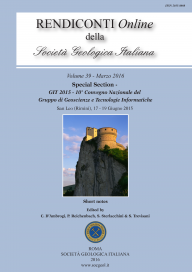
Application of a sediment connectivity GIS-based index in a basin undergoing glacier retreat: the case study of the Navizence catchment
Beatrice Goldin (a), Benjamin Rudaz (b) & Eric Bardou (c)
(a) CNR-National Research Council, Padova, Italy. E-mail: beagold82@gmail.com
(b) University of Lausanne, Institute of Earth Sciences, Lausanne, Switzerland
(c) DSM-Consulting, Nax, Switzerland
Volume: 39/2016
Pages: 35-38
Abstract
The extent of the melting from retreating glacier can largely influence sediment transport processes at basin scale, affecting significantly the downstream fluvial system. The analysis of spatial sediment transport pathways and of different contributions of the sub-catchment as sediment sources allows the evaluation of the melting impacts on the potential sediment connectivity, i.e. the degree of connection that controls sediment fluxes between different segments of a landscape, in basins undergoing glacier retreat.
The goal of this first study is inferring the effect of the connectivity changes on a basin with a sediment dynamic influenced by glacial features. Achieving this task was possible thank to a topography-based model of sediment connectivity (IC, Connectivity Index), as developed by Cavalli et al. (2013), was applied to Navizence catchment in the Southern Swiss Alps to analyze new potential connectivity pattern due to the retreat of the main glacial edifice (Zinal glacier). To analyze sediment connectivity evolution, two Digital Terrain Models (DTMs) were used: a current DTM, obtained from high resolution photogrammetry (2 m), describing the terrain at the time of the survey (2010); a post-glacial DTM, derived from application of the Slope Local Base Level (SLBL) (Jaboyedoff & Derron, 2005) technique to the current DTM, describing the terrain after forty years of glacier retreat. As a proxy of the impedance to sediment fluxes, a weighting factor derived from tabled values of hydraulic roughness (Manning's n) was applied. In order to evaluate the potential evolution of sediment connectivity in a glacierized environment, future lateral moraines, that would be formed after glacial retreat, were mapped and inserted into the DTM based on expert knowledge.
Qualitative analysis of the variation of the geomorphologic index suggested that the degree of sediment connectivity in Zinal glacier is a key factor in controlling the release of sediment between hillslopes and main channel. It also emphasizes the role of lateral moraines development in influencing the future sediment fluxes from the glacial zone, acting as barriers for the downward sediment transport.
Keywords
Get Full Text